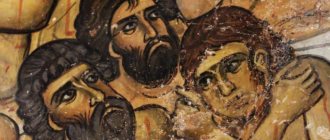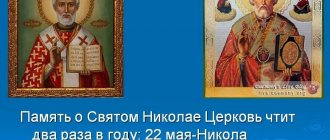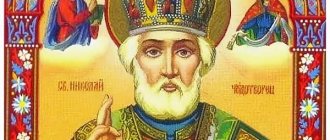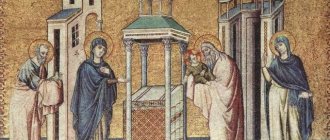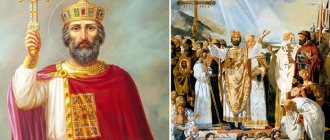Date in 2022: July 28, Wednesday.
The baptism of Rus' began with Prince Vladimir Svyatoslavovich accepting the Christian faith according to the Greek rite. After this, they began to baptize Slavs en masse in Kyiv, Novgorod and other cities of Rus'. The year of baptism is considered to be 988. The date of celebration is June 28, since at this time the day of memory of Vladimir is celebrated.
| When is it celebrated? | Every year on July 28, the day is not an official holiday |
| When and by whom was it founded | The holiday was established on June 1, 2010 by the President of the Russian Federation, Dmitry Medvedev. A corresponding proposal was made by representatives of the Russian Orthodox Church |
| Traditions | Traditionally, liturgies and religious processions are held on this day. One of the features of the holiday is that bells begin ringing in churches at noon. |
The Day of the Baptism of Rus' is the main holiday for all Orthodox Christians in Russia. This date has a special meaning for every Russian person. Since the adoption of Orthodoxy, a new round of history began. The day and month of the baptism of Rus' coincides with the day of remembrance of St. Prince Vladimir, who baptized the Slavic people en masse. The prince chose Orthodoxy over other religions, thereby determining the fate of his people.
When is it celebrated?
Figure 1. Procession on the anniversary of the Baptism of Rus'
On June 1, 2010, Dmitry Medvedev approved the official date for celebrating the Day of the Baptism of Rus'. Patriarch Alexy II approached the government of the Russian Federation with the initiative. In addition to Russia, he proposed making appropriate changes to the list of state memorial countries to the presidents of Ukraine and Belarus.
It was no coincidence that July 28 was chosen as the date of celebration. On this day the church celebrates the memory of Equal-to-the-Apostles Prince Vladimir. In history he is known as Vladimir the Red Sun, the baptist of Rus'.
In 2022, July 28 falls on a day off - Sunday.
Interesting! The day of the baptism of Kievan Rus-Ukraine has been solemnly celebrated since 2008. The neighboring state also celebrates a similar holiday on July 28.
Was Rus' forcibly baptized?
Baptism of Rus'. Sketch by Viktor Vasnetsov for the painting of St. Vladimir's Cathedral in Kyiv. 1890 State Tretyakov Gallery
The oldest sources do not report any violence: neither from other states, nor from the Kiev authorities. The literature still refers to reports of some resistance to baptism with armed confrontation (for example, in Novgorod), but this is unreliable information based on later speculation and legends.
Who should be congratulated
The Baptism of Rus' is a significant event for the entire Orthodox world. The decision of Prince Vladimir influenced the course of historical events, the culture and morality of the Slavic tribes.
The renunciation of paganism and the acceptance of Christ had a beneficial effect on the development of the Russian people. Thanks to the new faith, writing came to Rus'. For a long time, churches served as educational institutions.
It is customary to congratulate all Orthodox Christians in Russia and other Slavic states on the holiday.
In addition: find out when Honey Savior is celebrated in 2022.
Reasons for accepting Orthodoxy
First of all, the Byzantines were interested in the adoption of Christianity by Russia. By imposing religious teachings on troubled neighbors, the state has more than once subjugated other tribes and peoples. The fact is that the adoption of religion obliged the inhabitants of the new territories to accept vassalage in relation to Byzantium. Thus the empire expanded its borders.
There were other prerequisites for the emergence of a single faith. Prince Vladimir understood that the disunity of the tribes was very harmful. Ancient Rus', in fact, was not a state. It was rather a kind of community of permanently warring principalities, connected more ethnically than at the state level.
And more developed countries considered the Rus to be barbarians. Moreover, these states themselves, in turn, were united by one thing - the presence of a common faith among the inhabitants. So, over time, Prince Vladimir came up with the idea of unifying the principalities and introducing a common religion in the territory.
Significant event associated with the Baptism of Rus'
Figure 2. Monument to Prince Vladimir on Borovitskaya Square in Moscow
The significant date coincides with the day of remembrance of the Holy Equal-to-the-Apostles Prince Vladimir.
Prince Vladimir is the son of Prince Svyatoslav and the housekeeper of Princess Olga - Malusha. The path to power for the future baptist of Rus' was difficult. He is remembered in history as a tough ruler. However, the adoption of the Christian faith radically changed the character of the Grand Duke.
The personal baptism of the ruler took place in 988 in Chersonesos. This date is also considered the year of the baptism of the entire Russian people. The baptism of Rus' began in Kyiv, where the prince brought Greek priests. Then the process of Christianization began throughout the rest of the territory.
Having converted to Orthodoxy, Vladimir changed radically:
- he made peace with almost all his neighbors. Military conflicts continued only with nomadic tribes, who regularly raided Rus';
- All wives and concubines were dissolved. The prince, according to all Christian traditions, married the Greek princess Anna;
- The death penalty was abolished in Rus'. This form of punishment for criminals was returned at the request of the Greek bishops;
- Vladimir became involved in charity work: access to the prince was open to all those in need.
Prince Vladimir died on July 15 (28), 1015. It happened not far from Kyiv in the village of Berestovoy. He was buried in the Tithe Church he founded.
The discovery of Vladimir's relics happened in 1635.
Remarkable! The image of Prince Vladimir is captured in cinema, literature and even cartoons. In many cities of Russia there are monuments to the Baptist of Rus'. In Moscow, a monument to the prince was erected on Borovitskaya Square.
Video “Prince Vladimir. Baptist of Rus'." Documentary
Was there resistance and protests?
Prince Gleb Svyatoslavovich kills the sorcerer at the Novgorod Veche (Princely Court). Painting by Andrey Ryabushkin. 1898 Nizhny Tagil Museum of Fine Arts
We know nothing about resistance and protests in the era of Vladimir. Another thing is that the Christianization of the entire population of Rus' was a long process: the chronicle reports some unrest in individual cities and regions of Rus' later, in the 11th century. To varying degrees, the protesters used slogans of pagan reaction. For example, in Suzdal in 1024 there were unrest due to famine, and pagan Magi (priests) took an active part in them. Under the year 1071 (in reality, the events most likely took place in 1074), the Tale of Bygone Years describes the adventures of the Kyiv boyar Yan Vyshatich in the Upper Volga region. Famine reigned in Rus' at that time, and unrest against the authorities began. Jan had to suppress them and even conduct a theological dispute with the Magi, who were depicted as the leaders of the protest. In Novgorod in 1071, a revolt against the prince and bishop was also led by a certain sorcerer; unrest occurred during the evening, but the decisive actions of the prince and his squad stopped them.
How to celebrate the holiday
Despite the fact that the date acquired official status only in 2010, the Baptism of Rus' was first celebrated in 1888. The 900th anniversary of Russian Christianity was celebrated throughout the country with solemn services and religious processions.
In 2022, the Slavic Orthodox world will celebrate the 1031st anniversary of the adoption of Christianity. On this day the following are traditionally held:
- statutory services;
- At exactly noon the bells ring in the temples. This tradition is widespread not only in the territory, but also in Moldova and Belarus;
- religious processions.
Not only representatives of the church, but also top officials of the state take part in the holidays.
The TV plot is “From Moscow to Kyiv: believers celebrate the 1030th anniversary of the Baptism of Rus'.”
history of the holiday
Figure 3. Baptism of Kiev residents in the waters of the Dnieper
There is a legend according to which Vladimir chose a faith for his subjects among several religions:
- Islam;
- Catholicism;
- Christianity;
- Judaism.
He sent Russian embassies to countries where these religions are preached to watch the services. Envoys returned from Constantinople who were delighted with the Christian ceremony. If you believe the legend, then this played a decisive role in the adoption of the new faith.
In 988, a mass baptism of Slavs took place. This process did not go smoothly everywhere. It is known that Novgorod resisted Christianization. Vladimir sent his uncle Dobrynya to the city. Only as a result of military pressure was it possible to baptize the Novgorodians.
In the remaining territories everything passed peacefully, the Slavs easily parted with paganism. Favorable ground has already been prepared for this. Christianity penetrated into Slavic territories long before official baptism. For example, Princess Olga was baptized back in 957 in Constantinople.
Who was before Prince Vladimir
Before Vladimir, who was popularly nicknamed the Red Sun, there were other rulers in Rus' who were interested in changing their confession. The most famous of them is the prince’s grandmother, Olga. Some chroniclers mentioned that the princess, who was born a pagan, over time began to show true Christian virtue. It is also mentioned that the ruler had an aversion to pagan idols. But historians are more inclined to believe that Olga decided to change her faith as a smart political move.
Many of the princess's contemporaries spoke with delight about her intelligence and insight. Nevertheless, Olga made a lot of efforts to spread Christianity in Rus', although her son Svyatoslav remained an ardent pagan.
View this post on Instagram
A post shared by Victor Ray (@v1cr4v)
Monument to Princess Olga in Kiev
However, the princess was far from the first in Russia to lay the foundation for Christian teaching. Before Olga, people converted to this faith back in the 800s. These were Varangians who served in Byzantium. They were in constant contact with the carriers of this religion, so over time they adopted it. In addition, there is no clear opinion when the so-called “first baptism of Rus'” took place, since there are many versions about the first Russians to convert to Christianity.
List of films dedicated to the baptism of Rus'
The topic often becomes a source of inspiration for directors and screenwriters. There are many feature films and documentaries dedicated to the baptism of Rus'. The most popular of them:
- documentary film “The Tale of the Baptism of Rus'”, directed by Valery Babich;
- series “Baptism of Rus'”, directed by Maxim Bespaly;
- documentary film “Traces of the Empire: The Baptism of Rus'. The choice that determined the course of Russian history", producer;
- film “The Baptist”, director Vladimir Bortko;
- documentary film “Prince Vladimir. Baptist of Rus'", a film by Doctor of Historical Sciences - Alexander Nazarenko.
Video: Series “Baptism of Rus'”
Historical significance of the adoption of Christianity
The adoption of Christianity greatly affected the culture of Rus'. Many artisans came from Constantinople and taught the locals various types of art. Ancient craftsmen adopted many crafts from Byzantium. This especially affected the architecture - the architects were inspired by the religious buildings of Constantinople and built structures that were not inferior in their beauty and scale. Also, icon painting appeared on the territory of the state, which over time gave impetus to the development of painting.
After baptism, Christianity also influenced the national identity of the Russians. The people opposed themselves to followers of Islam and polytheism, as well as representatives of other faiths - Germans who professed Catholicism and adherents of Judaism.
As Prince Vladimir believed, the church became a stronghold of the unity of the people. This was especially noticeable in difficult times, when it was necessary to fight invaders. The clergy constantly called on the princes of the warring territories to forget about their differences and join forces to defeat the enemy.
The Baptism of Rus' contributed to the emergence of a special layer of Russian society - the clergy. Monasteries and churches gradually acquired the status of the main spiritual centers of the country. Until the reign of Peter I, the clergy was independent of secular power and even had its own influence.
The baptism of Russian cities and the establishment of a church organization in Rus'
After the baptism of the two main centers of Rus', Christianity spread to other lands and cities. In 997, the Kiev metropolis was established, subordinate to the Patriarchate of Constantinople. It included the dioceses of Novgorod, Rostov and Suzdal, Chernigov and Novgorod-Seversk, Vladimir-Volyn and Kovel, Polotsk and Glubokoe, Turov and Mozyr.
The first bishops and metropolitans of Rus' were Greeks; liturgical books in Old Church Slavonic were brought from Bulgaria. The first stone temples were built by craftsmen invited from Byzantium. In 990, the first cathedral of Rus' was founded - the Church of the Tithes. It was built by Greek and Russian masters over the course of 6 years. It got its name from the fact that the prince allocated a tenth of his income (tithe) for its maintenance.
Why not somewhere else?
According to Belyaev, this could not have happened anywhere else for the following reasons. The prince's plans were to marry Anna, a Byzantine princess. Before that, he had two legal wives and about 300 concubines. Making a Byzantine princess your wife was a very honorable thing. Judge for yourself. This was denied to the German Emperor Otto himself. And Prince Vladimir succeeded! And the princess was brought from Constantinople to Vladimir in Chersonesus.
For several centuries, Byzantium attracted barbarian tribes into the fold of the Christian Church. In addition, she sought to maintain peace on her own borders. Therefore, Vladimir was a completely suitable party.
But neither the Byzantine emperor nor the patriarch could allow a woman of such high rank to go outside the empire just like that. That is, without being married in a legal Christian marriage according to all church canons. It follows that the question of where to baptize Prince Vladimir and where to get married could only be decided unambiguously - only on the territory of Byzantium, of which Chersonesus was a part.
The first historical facts of the baptism of the Slavs
Rus' was no exception. The first reports of the adoption of Christianity date back to the end of the 8th century, when, according to the Byzantine source “The Life of St. Stephen of Sourozh,” an army of Rus under the command of Prince Bravlin took Sudak (Sourozh). According to legend, the prince was punished by God with illness for plundering the city. In order to be saved, he accepted the Christian faith.
Historians claim that the predecessors of Oleg and Igor on the Kiev throne, princes Dir and Askold, were Christians. They were baptized “with the boyars” after the campaign against Constantinople.
Baptism in Korsun
There are two versions of the Russian army’s campaign against Chersonesus. According to one of them, Vladimir, as a loyal ally of the Byzantine basileus Basileus II the Bulgarian-Slayers, returned the rebellious city to his hand. Chersonesos joined the uprising of the commander Bardas Phocas, broke away from Byzantium, and the capture of the city was not a war with the basileus, but, on the contrary, help against the rebels.
According to another version, Vladimir really helped Vasily II in the internal war against Varda Phokas, for which he sent an army of 6,000 soldiers. In exchange, he was promised an alliance and dynastic marriage with the emperor's sister, Princess Anne. This union put him on the same level as the Byzantine basileus. But the emperor was in no hurry to fulfill his obligations. Therefore, the Russian army captured Korsun to demonstrate the seriousness of its intentions.
Be that as it may, after the capture of Korsun, Vladimir waited for Anna with the churchmen and was baptized. After which he got married and went to Kyiv. Leaving Chersonesos, he took out all the icons, utensils and relics of saints, as well as Greek copper statues. But he left behind the Church of St. John the Baptist.
Destruction of the Kyiv temple, baptism of the people of Kiev
Returning to Kyiv, Vladimir ordered the destruction of the temple, which he himself had erected in 980. And if he ordered the idols of Khors, Dazhdbog, Stribog, Semargl and Mokosha to be chopped up and thrown into the fire, then Perun was especially punished. By the will of the prince, he was tied to the tail of a horse and dragged to the river, beating him with sticks. The people detached by Vladimir went down to the Dnieper rapids, preventing the idol from landing on the shore. Thus, he was symbolically expelled from Rus'.
Victor Vasnetsov. Baptism of Rus'. 1885-1896
Having dealt with the former gods, Vladimir ordered the people of Kiev to come to the banks of the Dnieper for Baptism:
“If anyone does not come to the river tomorrow - be it rich, or poor, or beggar, or slave - he will be my enemy.”
According to the chronicle, the majority of Kiev residents happily came to the Dnieper, saying that if the Greek faith were bad, the prince and the boyars would not have accepted it. In addition, the Christian community of the city was already large by that time.
Religion of the states surrounding Ancient Rus'
Rus' was surrounded by countries that had already adopted one of the world religions. So Poland in 966, during the reign of Prince Mieszko from the Piast family, was baptized according to the Latin rite. The Hungarian prince Istvan in 1000 accepted the crown of the Christian king from the hands of Pope Sylvester II. The Bulgarian kingdom converted to Islam in 922 under Tsar Almas. The top of the Khazar Khaganate, living out the last decades of its existence under the blows of the Russian princes, professed Judaism. But the most powerful state in the region was the Orthodox Byzantine Empire.
In all newly converted states, religion penetrated through ruling dynasties and groups. It was they who needed unified state religions, which were supposed to unite tribal unions into single powers and sanctify the power of the ruler.
What did the font look like?
Understanding the question of where Prince Vladimir was baptized, it will be interesting to find out how this happened. It is assumed that initially the font in which the sacrament was performed was exactly as it was depicted by the artist Vasnetsov in the painting in the Vladimir Cathedral in Kyiv.
In Chersonesos it was carved into the rock; at the moment its depth is 74 centimeters. When it was opened in the 80s of the 19th century, it was discovered that the entire recess was lined with marble. The cross located at the bottom was also lined with marble. Unfortunately, over time, all this splendor was stolen, and today there is a bare rock with a light brown color. The cross has also not survived.
At that time, the baptismal chapel was perceived as an ordinary temple. In the 90s of the 19th century, the assumption that the marble font carved into the rock was exactly the place where Prince Vladimir was baptized was expressed by Alexander Lvovich Bartier, an outstanding Russian engineer. During the Soviet years, Belyaev's expedition explored the monument in its entirety. And from historical, and from archaeological, and from canonical, and from liturgical points of view.
It is now considered proven that it was on the site of the former temple (baptismal chapel), in the found font, that the baptism of Vladimir in Chersonesos took place. After S. A. Belyaev toured all of Europe with a report on this topic, the scientific community accepted this evidence.
Baptism of Veliky Novgorod
The next important center of Rus' was Mister Veliky Novgorod. It was the largest city of northern Rus', the first capital of Ancient Rus' of the Rurikovichs. There was also an important economic aspect - it was the northern gateway of the route “from the Varangians to the Greeks.”
Christian communities have existed in Novgorod for a long time. They lived peacefully with the bulk of the pagan population. But the Novgorodians, taught by the Magi, did not want to be baptized by the will of Kyiv. Therefore, Vladimir sent an army with priests, led by his uncle, the governor Dobrynya and the thousand-man Putyata. The church mission was headed by Joachim Korsunyanin.
Baptism was accompanied by “evil flogging.” Despite the numerical superiority of the Novgorodians, Putyata managed to decapitate the uprising. And when Dobrynya set fire to the city, the pagans asked for peace. Since then they have said about the baptism of Novgorod:
“Putyata baptized with a sword, and Dobrynya with fire”
